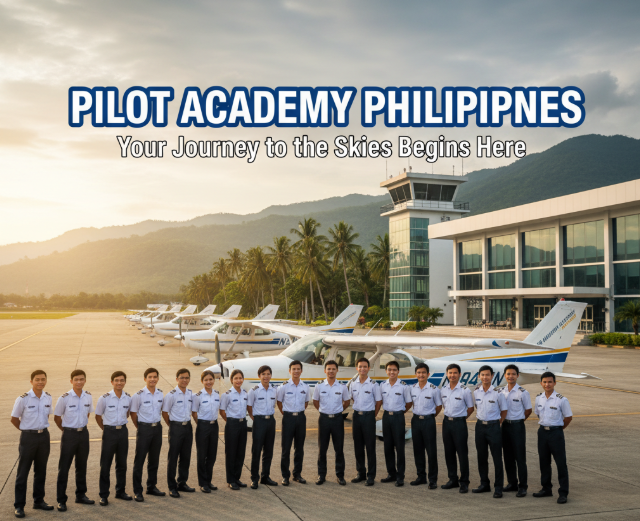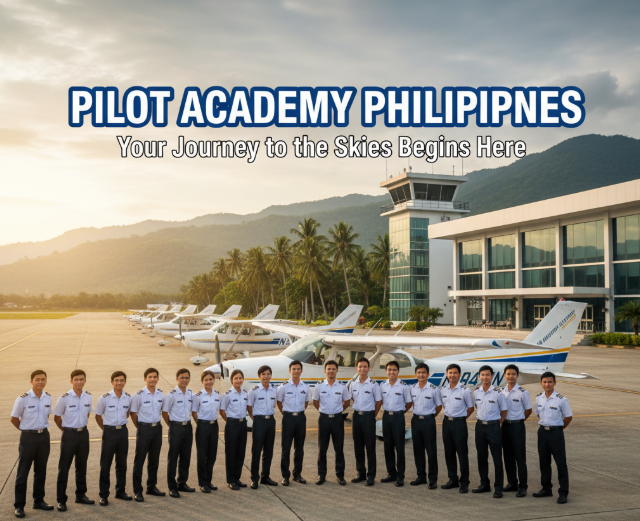
Introduction to Pilot Academy in Philippines
The aviation industry plays a significant role in the global economy, and the Philippines, with its strategic location in Southeast Asia, is no exception. For many aspiring pilots, the Philippines is a destination of choice for flight training due to its world-class institutions and booming aviation sector. This blog will take you through everything you need to know about pursuing a career as a pilot in the Philippines. From the top pilot academies to the eligibility requirements, this guide will provide detailed insights into pilot training and what you can expect as you embark on this exciting career path.
What is a Pilot Academy?
A Pilot Academy, also known as a Flight Academy or Aviation Institute, is a specialized educational institution that trains individuals to become pilots. These academies provide essential theoretical and practical training, equipping students with the knowledge and skills required to fly aircraft safely and professionally. In the Philippines, pilot academies offer various programs, ranging from private pilot licenses to commercial and airline transport pilot licenses, alongside specialized courses such as flight instructor training and space navigation.
Importance of Aviation in the Philippines
The Philippines is one of the most geographically dispersed countries in the world, with over 7,000 islands. This makes air travel not only convenient but essential for business, tourism, and government operations. The aviation industry in the Philippines has grown tremendously over the past few decades, driven by increased demand for both domestic and international flights.
The country is also home to numerous airlines, including Cebu Pacific, Philippine Airlines, and AirAsia Philippines, all of which provide ample job opportunities for trained pilots. With the aviation sector growing rapidly, there is a consistent demand for qualified pilots, making the Philippines an ideal location for aspiring aviators to begin their careers.
History and Development of Aviation in the Philippines
Early Aviation History of the Country
The history of aviation in the Philippines dates back to the early 1900s when the first aircraft flew over the country. In 1910, the first Filipino pilot, Julian J. P. Moxon, made his first successful flight in Manila. Following this, aviation in the country slowly began to develop, primarily through military efforts during World War II. After the war, the Philippines started to develop its civilian aviation infrastructure, leading to the establishment of airlines and the expansion of airports.
Milestones in Philippine Aviation
- Philippine Airlines (PAL): Established in 1941, PAL became the first commercial airline in Asia to operate an international flight, connecting Manila to Hong Kong.
- Military Aviation: The Philippines’ Air Force, established in 1947, played a critical role in the development of aviation in the country and continues to maintain a strong presence today.
- Space Programs: In recent years, the Philippines has started to develop its space program, with projects aimed at building a national space agency and exploring space technologies, setting the stage for future collaborations with international space agencies such as NASA and ISRO.
Current Role of Pilot Academy in Philippines
Pilot academies in the Philippines today function as crucial training institutions that provide aspiring pilots with a comprehensive education in both theoretical and practical aspects of aviation. These institutions offer various programs designed to cater to the growing demand for qualified pilots in the country and abroad.
The Role of Pilot Academies
Pilot academies in the Philippines are not only focused on civil aviation but also play an important role in supporting the country’s military and defense sectors. These academies offer tailored programs for students aspiring to work with the Philippine Air Force, as well as training for potential astronauts involved in government space initiatives.
Aviation Training for Space Exploration
While primarily focused on commercial aviation, several pilot academies in the Philippines are exploring advancements in training related to space exploration. This is in line with the global trend of combining aerospace and aviation programs, including collaborations with international space agencies.
Eligibility, Training, and Skills Required
Basic Qualifications for Aspiring Pilots
To enroll in a pilot academy in the Philippines, prospective students must meet certain eligibility criteria:
- Education: A high school diploma is the minimum requirement, but many academies recommend a college degree, particularly in aviation, engineering, or mathematics.
- Age: Most academies accept students between the ages of 17 and 35. However, the age requirement can vary depending on the specific program.
- Health: Candidates must pass a medical examination to ensure they meet the health standards required to operate an aircraft.
Technical & Soft Skills Required
Pilot training is not just about learning how to fly an aircraft; it also involves developing a deep understanding of aviation principles, weather patterns, and air traffic control procedures.
- Technical Skills: Aspiring pilots need to learn navigation, meteorology, aviation regulations, flight planning, and aircraft systems.
- Soft Skills: Strong communication skills, leadership, decision-making, and teamwork are essential. Pilots must remain calm under pressure and be able to make quick decisions in challenging situations.
Institutes, Academies, and Training Centers in the Philippines
Top Pilot Academies in the Philippines
Several well-established pilot academies provide quality aviation education in the Philippines. Here are some of the leading institutions:
- Philippine Airlines Aviation School (PALAS)
Located in Pasay City, PALAS is affiliated with Philippine Airlines and offers comprehensive training programs for aspiring pilots. - Flight School Manila
Flight School Manila provides a wide range of training options, from private pilot licenses to commercial pilot training. - AeroCare Aviation Academy
Situated in Davao, AeroCare offers various aviation programs, including flight training for both fixed-wing and rotary-wing aircraft. - Ateneo de Manila University Aviation Academy
Ateneo’s aviation academy offers specialized training programs in collaboration with local and international aviation partners. - Cebu Pacific Air Flight Academy
Established by Cebu Pacific, this academy trains pilots specifically for the airline and is one of the country’s largest training facilities.
Government Initiatives in Aviation Training
The Philippine government is also actively involved in supporting aviation training programs. Agencies like the Civil Aviation Authority of the Philippines (CAAP) and the Department of Transportation (DOTr) provide regulatory oversight and promote the growth of the aviation industry. Additionally, the Philippines’ increasing collaboration with global aerospace organizations provides aspiring pilots with international exposure and opportunities.
Technology and Innovation in Aviation Training
Flight Simulators and Virtual Training
Modern pilot training programs in the Philippines use state-of-the-art flight simulators to provide hands-on experience in various flight conditions. These simulators allow students to practice emergency procedures and handle a variety of flight scenarios without leaving the ground.
AI and Digital Cockpits
As technology advances, AI is increasingly being integrated into flight training programs. AI is being used to create more advanced simulations and even assist in cockpit training. Digital cockpits, equipped with advanced avionics, are becoming standard on modern training aircraft, giving students the opportunity to train on cutting-edge technology.
Challenges Faced in Pilot Training in the Philippines
Despite the growing popularity of aviation training in the Philippines, there are several challenges that aspiring pilots must be aware of:
- Infrastructure Gaps: While the country has a strong aviation industry, some regions still lack advanced training facilities and resources.
- Cost of Training: The cost of pilot training in the Philippines can be substantial, ranging from PHP 1.5 million to PHP 3 million depending on the program and academy. This can be a significant barrier for many prospective students.
- Regulatory Hurdles: Meeting the requirements for international certification can sometimes be challenging due to changing regulations and inconsistent standards across different countries.
- Brain Drain: Many Filipino-trained pilots seek employment opportunities abroad, which, while providing international exposure, can result in a shortage of local pilots.
Future of Pilot Academy in Philippines
The future of pilot training in the Philippines is bright, with several factors contributing to the growth of the sector:
- Space Tourism: As the space tourism industry grows, Filipino pilots may have opportunities to join space agencies or commercial space ventures.
- AI Integration: The role of artificial intelligence in aviation training will continue to expand, providing more immersive and advanced training programs for pilots.
- National Projects: Similar to India’s Gaganyaan mission, the Philippines may begin to invest in national space exploration projects, opening up more opportunities for aviation and aerospace professionals.
Career Path & Opportunities
Step-by-Step Guide to Becoming a Pilot
- Education: Complete the required education, which includes a high school diploma and ideally, a degree in a related field.
- Pilot License: Enroll in a pilot academy and complete the necessary training programs to obtain a private, commercial, or airline transport pilot license.
- Advanced Training: Consider additional training, such as flight instructor courses or space program certifications.
- Employment: Secure a job with airlines, private aviation companies, or even space programs.
Salary Expectations and Global Opportunities
The salary of a pilot in the Philippines varies depending on the type of aircraft they fly and their experience. On average, a commercial pilot earns around PHP 50,000 to PHP 150,000 per month. However, pilots who work internationally or for major airlines can earn significantly higher salaries.
FAQs
- How much does pilot training cost in the Philippines?
Pilot training in the Philippines can cost anywhere between PHP 1.5 million to PHP 3 million, depending on the academy and the type of license. - Which is the best aviation institute in the Philippines?
Several reputable institutions offer high-quality training, including PALAS, Cebu Pacific Flight Academy, and Flight School Manila. - What qualifications are needed for pilot training in the Philippines?
Basic qualifications include a high school diploma, passing a medical examination, and meeting age requirements. - Is international flight training available in the Philippines?
Yes, several Filipino aviation academies are accredited by international aviation organizations, allowing students to train for international careers. - What is the future of aviation in the Philippines?
The future looks promising, with advancements in technology, space tourism, and increasing demand for skilled pilots both locally and globally.
Conclusion
Aviation offers an exciting and rewarding career, and the Philippines provides an excellent environment for aspiring pilots to receive world-class training. Whether you are looking to become a commercial pilot, a flight instructor, or pursue a future in space exploration, the country’s aviation academies offer comprehensive programs to help you achieve your dreams.
![Image: Students inside a flight simulator in Philippines]
![Image: Modern pilot training aircraft in Philippines]
This comprehensive guide is your first step toward becoming a skilled and qualified pilot in the Philippines. Take the plunge, and explore the endless skies ahead!
